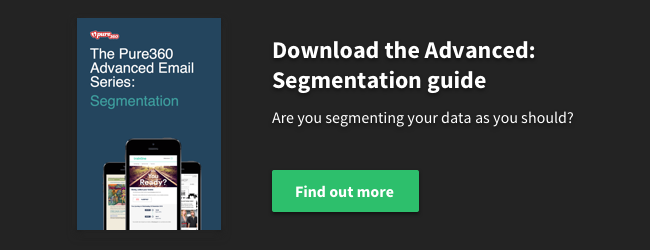A database will only tell you so much – most of which is about the past. Sophisticated segmentation strategies are about predicting the future.
But before you reach for your crystal ball there are more reliable ways of looking at the future. There’s technology available that allows you to gain insight, spot patterns and trends so that you can target, prompt and incentivise behaviour.
In the final part of our guide to segmentation we look at how you can segment your data to shape your customer’s future behaviour. If you’ve not read part one or part two yet then don’t forget to see how you can segment your recipients based on the past actions and current interests before moving on to these more sophisticated techniques.
Get the whole picture
Most companies have multiple ways customers can interact with them – on the phone, social, email, through stores or offices and on their website or apps. Always look at all of your customers’ behaviours regardless of where they happen so you can send relevant communications to them; for a retailer this might be seeing that a customer only shops in-store.
It might be worth sending them a regular recruitment campaign for your eCommerce site but if they don’t respond then send them information that is the most relevant to them. In this case this may mean not sending them lots of emails about online exclusives and promotions but instead promoting in-store services and offers. Solutions such as PureIntelligence will help you gain insight on all of your customers’ behaviours with a single customer view of all of the interactions.
Follow the crowd
It’s all very well telling customers about products you know they’ve bought before but how do you get them to buy something different? Inspire customers to make a purchase by providing crowdsourced bestsellers and recommendations. The tactic of ‘people who liked this also liked…’ from internet giant Amazon is well known and works well. The behavioural targeting tools within our PureTargeting solution enable you to display crowdsourced recommendations as well as products based on the customer’s browsing and transactional history. This is an excellent tool for cross-selling to existing customers and inspiring an additional purchase.
Right time, right place
Looking at what a customer has done will give you a clue about what they’re about to do.
This might be looking at the types of email communications your customer has responded to in the past, how often they purchase or what offers they respond to. Tailor your emails around that and you may improve the efficiency and ROI of your email marketing. This type of segmentation is often known a ‘Propensity’ and it’s simply about knowing when and how to contact your customer. It’s far more productive to strike when their propensity to spend is at its highest and will mean you won’t waste time and effort sending them emails when they’re unlikely to respond. Again PureIntelligence will offer you the insight you need to spot these trends and patterns in your customers’ behaviours.
These are just a few of the advanced segmentation strategies you can use to create a better relationship with your recipients.
Don’t forget to read part one and part two of this guide which cover the basic and intermediate strategies of segmentation.
If you’ve got any specific questions on how you can develop your email segmentation strategy then don’t forget to contact your Account Manager who will always be happy to help.

